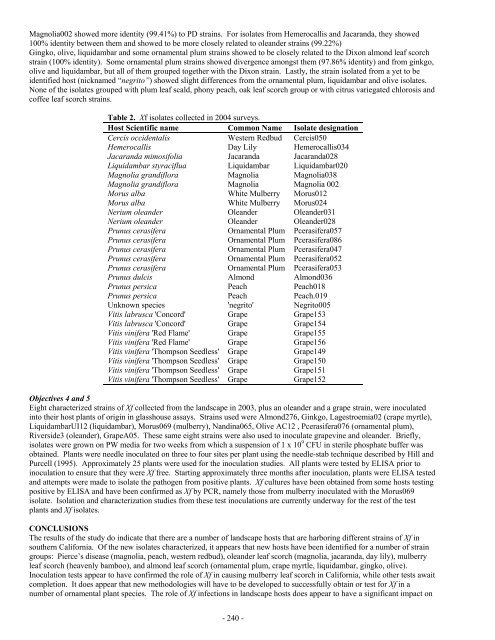Impact Of Host Plant Xylem Fluid On Xylella Fastidiosa Multiplication ...
Impact Of Host Plant Xylem Fluid On Xylella Fastidiosa Multiplication ...
Impact Of Host Plant Xylem Fluid On Xylella Fastidiosa Multiplication ...
You also want an ePaper? Increase the reach of your titles
YUMPU automatically turns print PDFs into web optimized ePapers that Google loves.
Magnolia002 showed more identity (99.41%) to PD strains. For isolates from Hemerocallis and Jacaranda, they showed<br />
100% identity between them and showed to be more closely related to oleander strains (99.22%)<br />
Gingko, olive, liquidambar and some ornamental plum strains showed to be closely related to the Dixon almond leaf scorch<br />
strain (100% identity). Some ornamental plum strains showed divergence amongst them (97.86% identity) and from ginkgo,<br />
olive and liquidambar, but all of them grouped together with the Dixon strain. Lastly, the strain isolated from a yet to be<br />
identified host (nicknamed “negrito”) showed slight differences from the ornamental plum, liquidambar and olive isolates.<br />
None of the isolates grouped with plum leaf scald, phony peach, oak leaf scorch group or with citrus variegated chlorosis and<br />
coffee leaf scorch strains.<br />
Table 2. Xf isolates collected in 2004 surveys.<br />
<strong>Host</strong> Scientific name Common Name Isolate designation<br />
Cercis occidentalis Western Redbud Cercis050<br />
Hemerocallis Day Lily Hemerocallis034<br />
Jacaranda mimosifolia Jacaranda Jacaranda028<br />
Liquidambar styraciflua Liquidambar Liquidambar020<br />
Magnolia grandiflora Magnolia Magnolia038<br />
Magnolia grandiflora Magnolia Magnolia 002<br />
Morus alba White Mulberry Morus012<br />
Morus alba White Mulberry Morus024<br />
Nerium oleander Oleander Oleander031<br />
Nerium oleander Oleander Oleander028<br />
Prunus cerasifera Ornamental Plum Pcerasifera057<br />
Prunus cerasifera Ornamental Plum Pcerasifera086<br />
Prunus cerasifera Ornamental Plum Pcerasifera047<br />
Prunus cerasifera Ornamental Plum Pcerasifera052<br />
Prunus cerasifera Ornamental Plum Pcerasifera053<br />
Prunus dulcis Almond Almond036<br />
Prunus persica Peach Peach018<br />
Prunus persica Peach Peach.019<br />
Unknown species 'negrito' Negrito005<br />
Vitis labrusca 'Concord' Grape Grape153<br />
Vitis labrusca 'Concord' Grape Grape154<br />
Vitis vinifera 'Red Flame' Grape Grape155<br />
Vitis vinifera 'Red Flame' Grape Grape156<br />
Vitis vinifera 'Thompson Seedless' Grape Grape149<br />
Vitis vinifera 'Thompson Seedless' Grape Grape150<br />
Vitis vinifera 'Thompson Seedless' Grape Grape151<br />
Vitis vinifera 'Thompson Seedless' Grape Grape152<br />
Objectives 4 and 5<br />
Eight characterized strains of Xf collected from the landscape in 2003, plus an oleander and a grape strain, were inoculated<br />
into their host plants of origin in glasshouse assays. Strains used were Almond276, Ginkgo, Lagestroemia02 (crape myrtle),<br />
LiquidambarUI12 (liquidambar), Morus069 (mulberry), Nandina065, Olive AC12 , Pcerasifera076 (ornamental plum),<br />
Riverside3 (oleander), GrapeA05. These same eight strains were also used to inoculate grapevine and oleander. Briefly,<br />
isolates were grown on PW media for two weeks from which a suspension of 1 x 10 9 CFU in sterile phosphate buffer was<br />
obtained. <strong>Plant</strong>s were needle inoculated on three to four sites per plant using the needle-stab technique described by Hill and<br />
Purcell (1995). Approximately 25 plants were used for the inoculation studies. All plants were tested by ELISA prior to<br />
inoculation to ensure that they were Xf free. Starting approximately three months after inoculation, plants were ELISA tested<br />
and attempts were made to isolate the pathogen from positive plants. Xf cultures have been obtained from some hosts testing<br />
positive by ELISA and have been confirmed as Xf by PCR, namely those from mulberry inoculated with the Morus069<br />
isolate. Isolation and characterization studies from these test inoculations are currently underway for the rest of the test<br />
plants and Xf isolates.<br />
CONCLUSIONS<br />
The results of the study do indicate that there are a number of landscape hosts that are harboring different strains of Xf in<br />
southern California. <strong>Of</strong> the new isolates characterized, it appears that new hosts have been identified for a number of strain<br />
groups: Pierce’s disease (magnolia, peach, western redbud), oleander leaf scorch (magnolia, jacaranda, day lily), mulberry<br />
leaf scorch (heavenly bamboo), and almond leaf scorch (ornamental plum, crape myrtle, liquidambar, gingko, olive).<br />
Inoculation tests appear to have confirmed the role of Xf in causing mulberry leaf scorch in California, while other tests await<br />
completion. It does appear that new methodologies will have to be developed to successfully obtain or test for Xf in a<br />
number of ornamental plant species. The role of Xf infections in landscape hosts does appear to have a significant impact on<br />
- 240 -











